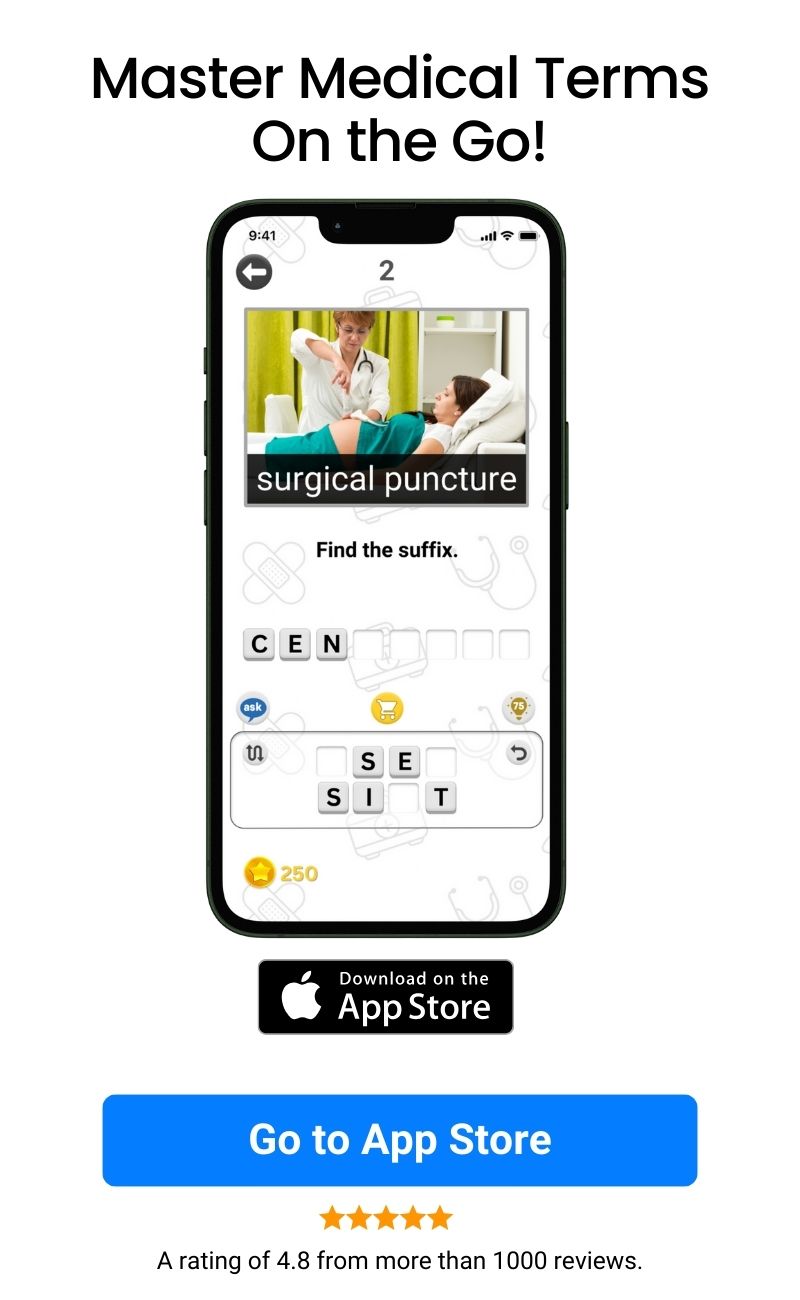As you progress through this quiz, you will learn some of the most common word roots and combining forms associated with the sensory system.
Quick Review for the Quiz
Check out the flashcard version for a more detailed review.
| Word Root | Combining Form | Body Part or Condition |
|---|---|---|
| acoust, acous | acoust/o, acous/o | sound or hearing |
| audi | audi/o | hearing |
| chori, choroid | chori/o, choroid/o | choroid |
| cochle | cochle/o | cochlea |
| conjunctiv | conjunctiv/o | conjunctiva |
| corne, kerat | corne/o, kerat/o | cornea |
| cycl | cycl/o |
ciliary body or ciliary muscle
|
| dacryocyst | dacryocyst/o | lacrimal sac |
| ir, irit, irid | ir/o, irit/o, irid/o | iris |
| labyrinth | labyrinth/o | labyrinth (inner ear) |
| lacrim, dacry | lacrim/o, dacry/o | tear or tear duct |
-
Question of
Find the combining form of the image highlighted.

-
acoust/o
-
hear/o
-
core/o
-
kerat/o
Correct Wrong
acoust/o, acous/o or audi/o is a combining form that refers to "sound" or "hearing". Hearing, or auditory perception, refers to the ability to perceive sounds through a sensory organ, such as the ear, by detecting periodic changes in pressure.
-
-
Question of
Find the combining form of the image pointed to.

-
chori/o
-
dacryocyst/o
-
blephar/o
-
choroid/o
Correct Wrong
chori/o or choroid/o is a combining form that refers to "choroid". The choroid forms part of the uvea, the eye's vascular layer, containing connective tissues and lying between the retina and sclera. The choroid supplies nutrients and oxygen to the outer retina.
-
-
Question of
Find the combining form of the image pointed to.

-
cochle/o
-
stapedi/o
-
cycl/o
-
dacry/o
Correct Wrong
cochle/o is a combining form that refers to "cochlea". In the inner ear, the cochlea is a hollow snail-like bone that is crucial for auditory transduction and essential for hearing. Sound is picked up by the cochlea through vibrations, which cause the stereocilia to vibrate. Upon receiving these vibrations, the stereocilia convert them into nerve impulses that can be interpreted by the brain.
-
-
Question of
Find the combining form of the image pointed to.

-
conjunctiv/o
-
cycl/o
-
pupill/o
-
dacryocyst/o
Correct Wrong
conjunctiv/o is a combining form that refers to "conjunctiva". A transparent, thin tissue covering the outer surface of the eye called the conjunctiva. By secreting mucus and tears, the conjunctiva of the eye lubricates and protects the eye. In addition to protecting against microbes from invading, it also plays a role in maintaining immunity.
-
-
Question of
Find the combining form of the image pointed to.

-
corne/o
-
dacryocyst/o
-
kerat/o
-
uve/o
Correct Wrong
corne/o or kerat/o is a combining form that refers to "cornea". The cornea is the transparent portion of the eye that protects the iris and the pupil, as well as allowing light to enter the inner chamber of the eye.
-
-
Question of
Find the combining form of the image pointed to.

-
cycl/o
-
cili/o
-
cochle/o
-
acous/o
Correct Wrong
cycl/o is a combining form that refers to "ciliary body" or "ciliary muscle". A ciliary body is a circular structure that is attached to the iris, the colored part of the eye. Fluid called aqueous humor is produced by the ciliary body in the eye. In addition, it contains the ciliary muscle, which changes the shape of the lens when you focus on a close object. It is called accommodation when this happens.
-
-
Question of
Find the combining form of the image pointed to.

-
dacryocyst/o
-
lacrim/o
-
salping/o
-
audi/o
Correct Wrong
dacryocyst/o is a combining form that refers to "lacrimal sac". A lacrimal sac, also known as a lachrymal sac, is the dilated upper end of the nasolacrimal duct. The lacrimal sac serves as a reservoir for tears overflowing, which are pumped inward and outward by the orbicularis muscle when blinking.
-
-
Question of
Find the combining form of the image pointed to.

-
ir/o
-
corne/o
-
blephar/o
-
palpebr/o
Correct Wrong
ir/o, irit/o or irid/o is a combining form that refers to "iris". The iris is the pigmented tissue at the eye's outer surface with a pupil in the center that is housed within it. The iris regulates the amount of light entering the eye by controlling the pupil diameter.
-
-
Question of
Find the combining form of the image highlighted.

-
labyrinth/o
-
salping/o
-
retin/o
-
phot/o
Correct Wrong
labyrinth/o is a combining form that refers to "labyrinth (inner ear)". Located inside the inner ear are organs that provide balance and hearing. The bony labyrinth consists of three specialized structures: the vestibule, the semicircular canal, and the cochlea. Its first function is to convert mechanical signals transmitted by the middle ear into electrical signals, which are then relayed on to the auditory pathway in the brain. A second function is to maintain balance by detecting motion and position.
-
-
Question of
Find the combining form of the image pointed to.

-
lacrim/o
-
irit/o
-
staped/o
-
cor/o
Correct Wrong
lacrim/o or dacry/o is a combining form that refers to "tear or tear duct". The tear duct is a narrow tube that drains tears from the eyes. Located beneath the eyelids are glands that make tears. Eyes are kept clean and moisturized by tears. After that, they drain through the tear ducts.
-




